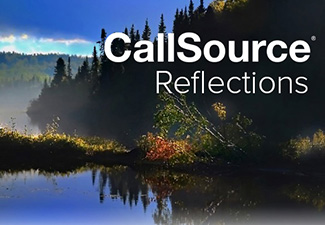 “CallSource® Reflections” is a blog series by CallSource’s® co-founder and President, Elliot Leiboff. Elliot co-founded CallSource® alongside the late Jerry Feldman in 1992. Over the years, Elliot has developed a small call tracking company to a full service lead generation performance organization. CallSource® invented call tracking. Elliot has witnessed a myriad of inventions, tried different strategies, invested in technologies and basically seen it all.
“CallSource® Reflections” is a blog series by CallSource’s® co-founder and President, Elliot Leiboff. Elliot co-founded CallSource® alongside the late Jerry Feldman in 1992. Over the years, Elliot has developed a small call tracking company to a full service lead generation performance organization. CallSource® invented call tracking. Elliot has witnessed a myriad of inventions, tried different strategies, invested in technologies and basically seen it all.
CallSource® is a classic American tale of an idea that turned into a business that has thrived through grit and determination. “CallSource® Reflections” is Elliot’s blog series on lessons learned as a business owner before the era of startups and VC funding.
Elliot’s monthly blog contributions take the reader on the journey of how our solutions have evolved.
Marketing Analysis has changed a lot during CallSource’s past 26 years
In the early 1990s, when CallSource invented call tracking as a service, most ad agencies emphasized “image advertising” and treated direct-response marketing as an ugly stepchild.
Industry awards were given for cleverness and style, not for results. This is not surprising, given the traditional lack of tools capable of accurately measuring consumer response. Consider that a handful of “Nielsen families” were presumed to represent the television viewing habits of the entire United States population!
Since the ascendance of cable and satellite TV and, especially, Internet marketing, more precise tools have been developed to measure consumer response. While, in the past, agencies were happy to focus on programs that bore little accountability for results, today, everyone understands the value of direct response marketing — and advertisers demand measurable results.
Modern lead attribution tools allow marketers to understand more and more of the increasingly complex consumer journey, both online and offline. While it was once considered sufficient to count the number of calls or clicks attributable to a particular ad source or marketing campaign, today, far more sophisticated metrics and analyses are not only possible but expected.
The sophistication of call attribution metrics evolved something like this:
# of calls received per ad source > # of calls received per campaign > # of unique callers > # of sales prospects > # of appointments set/sales closed > ratio of appointments/sales closed to # of prospects > # of mishandled opportunities > ranking of company performance vs. peers > ranking of call handler performance > identification of individual call handling skill gaps & prescription of targeted coaching
The sophistication of digital lead attribution metrics evolved something like this:
# of website visits > # of unique visitors > # of clicks > # of web form completions > # of calls from website > # of leads from “web billboard” ads > identification of last site visited > # of responses by AdWord > Social Media responses > Consumer journey cross-domain and cross-device > Integrated, real-time reporting of all marketing-generated calls, chats, web forms, and texts
The increasingly sophisticated ability to track and measure all forms of consumer response provides the opportunity to evaluate where marketing dollars are best spent and to understand which ad sources and marketing campaigns most effectively generate or nurture productive and affordable leads.
When we collect sufficient consumer response data and analyze it using the best available tools, we see that the customer journey is rarely influenced by just one marketing campaign or ad source. While our Google reports might be telling us that nearly all of our leads originate either from Google or from our own websites, a deeper analysis often contradicts this.
To begin with, your own website may be optimized for search, but when the search term that brought the consumer was your company name, it was some other form of marketing or advertising that planted your name or web address in that consumer’s mind. Google does, indeed, deliver many leads – but it is often just the next-to-last step in a complex consumer journey to your website.
A car buyer, for instance, might begin her search on a manufacturer’s website, find a local dealership and visit their website to check their inventory. She may then check on social media for vehicle and/or dealership reviews. After that, she might visit a website that reports the value of her trade-in. After all that, she may use Google to get contact information for her local dealer and call them or revisit their website.
Most of that complex journey is not revealed in a Google report or from the reporting of most digital marketing agencies, and a dealership might not realize the importance of visibility on those nurturing websites.
A consumer in need of an air conditioner might search Consumer Reports or Google “Best Air Conditioner” and search various rating service websites. He might then visit the manufacturer’s dealer locator page or a referral site to find a local contractor to sell and install the unit. Most of this journey is also hidden from a Google report or a report from many digital marketing agencies.
Understanding the consumer journey is perhaps even more important to those who generate and nurture leads for a living. A dealer locator rarely gets credit for leads that originate on their sites but visit other sites before landing at the dealer’s website. A lead generation company that relies on affiliates may not have an accurate accounting of which leads come from which affiliates. Further, they too might lose attribution whenever a lead they generate takes an indirect route to their client’s website. A Cars.com or KBB.com lose attribution for leads they nurture when consumers visit intervening sites before arriving at the website of their client dealers.
Many lead generation and web analytics companies use cookies to track consumers. This approach fails with web visitors who don’t accept cookies or who clear them – or who set their browser to an incognito mode to avoid remarketing spam. In such instances, the media companies won’t get proper attribution for a lead, and the business won’t recognize return visitors.
Fortunately, new technologies like AIsm and EveryLead® answer many of the issues outlined in this article. It is now possible for digital media companies and the businesses that employ them to track consumer journeys across domains and across devices without the use of cookies. All leads, whether they arrive via telephone, chat, text, or web form, can be displayed in a single, real-time dashboard plus a series of detailed reports.
AIsm is a service mark of AutoID, LLC.
EveryLead® is a service mark of CallSource, Inc.

